CETM10 Assignment: Tendering, Project Management in Sri Lanka
VerifiedAdded on 2022/01/27
|11
|4958
|237
Report
AI Summary
This report examines the techniques employed in tendering for construction contracts in Sri Lanka, detailing the standard procurement procedures and various methods utilized within the industry. It explores how project managers navigate the commercial and contractual complexities of large, complex projects, particularly within the Sri Lankan context. The analysis includes an overview of the Government Bid Evaluation Procedure (GBEP), different tender types (open, selective, negotiated, single-stage, and two-stage), and the role of the National Procurement Agency (NPA). The report also addresses the challenges of project management in the dynamic construction environment, emphasizing the need for adaptable approaches to handle uncertainties and complexities. Additionally, it highlights the importance of understanding commercial and contractual issues to mitigate risks, prevent disputes, and ensure project success in the Sri Lankan construction sector. The report stresses the importance of adapting project management strategies to the specific characteristics of large-scale projects in Sri Lanka, and the need for effective knowledge management and robust legal frameworks to support industry-wide advancements.
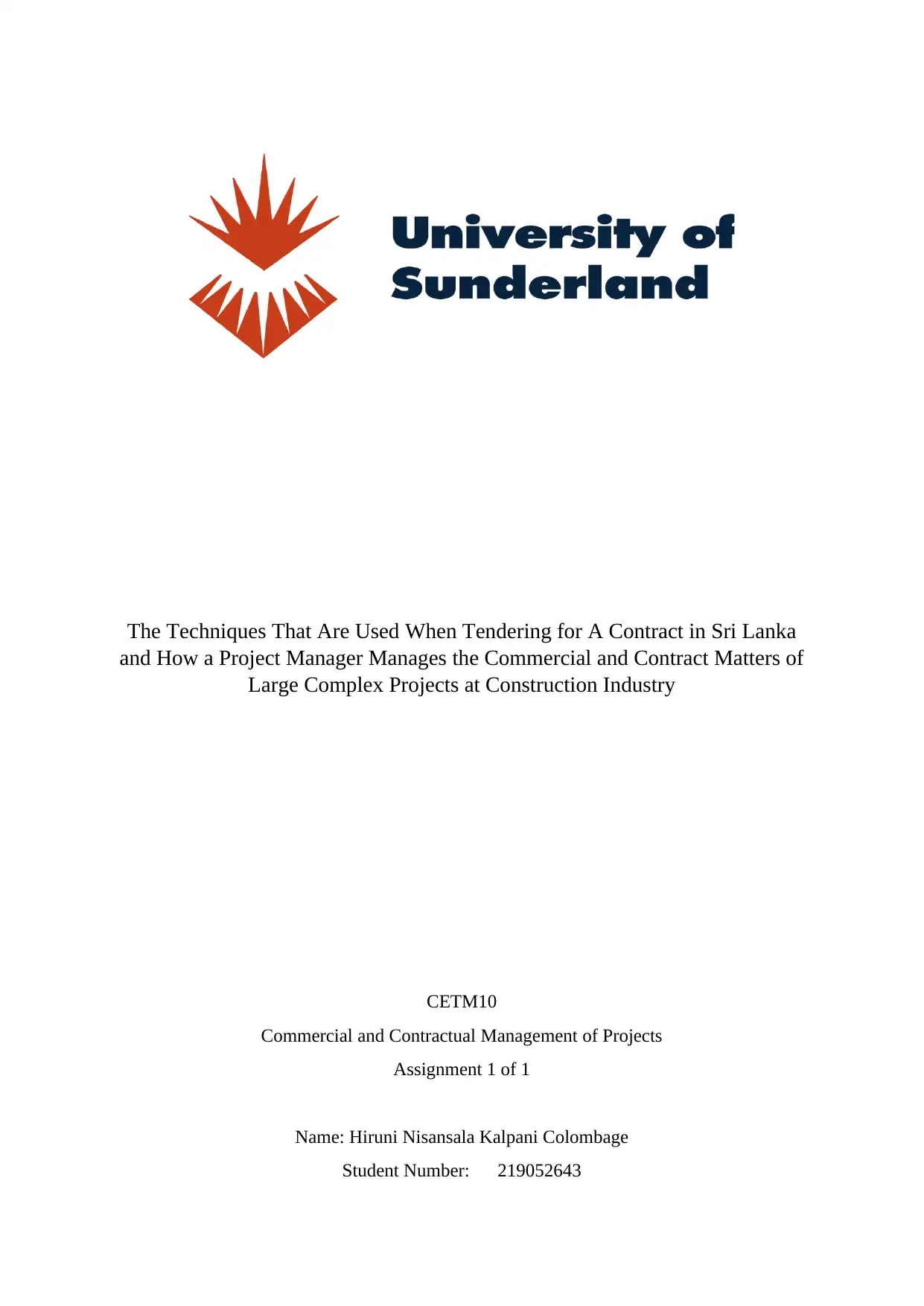
The Techniques That Are Used When Tendering for A Contract in Sri Lanka
and How a Project Manager Manages the Commercial and Contract Matters of
Large Complex Projects at Construction Industry
CETM10
Commercial and Contractual Management of Projects
Assignment 1 of 1
Name: Hiruni Nisansala Kalpani Colombage
Student Number: 219052643
and How a Project Manager Manages the Commercial and Contract Matters of
Large Complex Projects at Construction Industry
CETM10
Commercial and Contractual Management of Projects
Assignment 1 of 1
Name: Hiruni Nisansala Kalpani Colombage
Student Number: 219052643
Paraphrase This Document
Need a fresh take? Get an instant paraphrase of this document with our AI Paraphraser
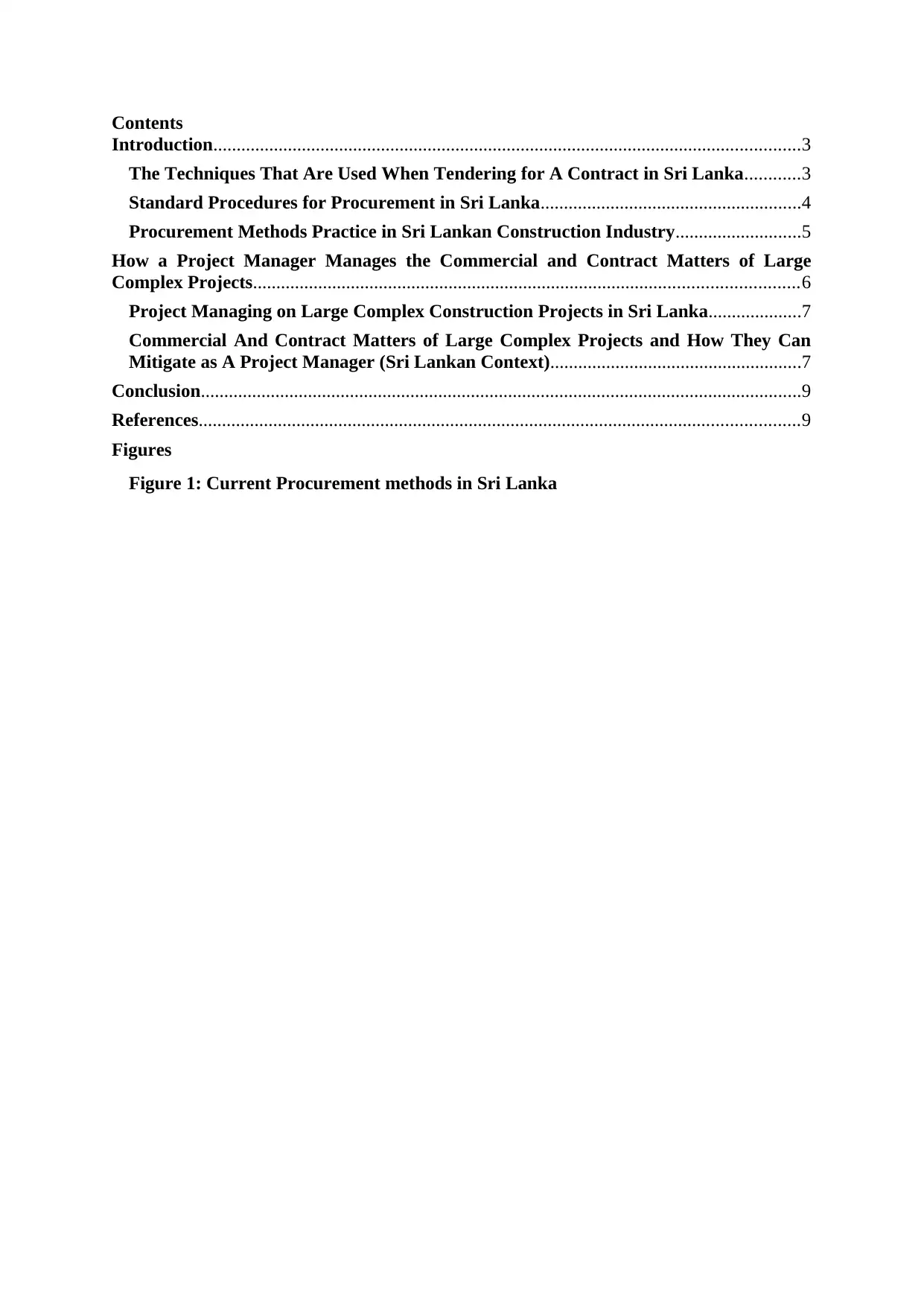
Contents
Introduction..............................................................................................................................3
The Techniques That Are Used When Tendering for A Contract in Sri Lanka............3
Standard Procedures for Procurement in Sri Lanka........................................................4
Procurement Methods Practice in Sri Lankan Construction Industry...........................5
How a Project Manager Manages the Commercial and Contract Matters of Large
Complex Projects.....................................................................................................................6
Project Managing on Large Complex Construction Projects in Sri Lanka....................7
Commercial And Contract Matters of Large Complex Projects and How They Can
Mitigate as A Project Manager (Sri Lankan Context)......................................................7
Conclusion.................................................................................................................................9
References.................................................................................................................................9
Figures
Figure 1: Current Procurement methods in Sri Lanka
Introduction..............................................................................................................................3
The Techniques That Are Used When Tendering for A Contract in Sri Lanka............3
Standard Procedures for Procurement in Sri Lanka........................................................4
Procurement Methods Practice in Sri Lankan Construction Industry...........................5
How a Project Manager Manages the Commercial and Contract Matters of Large
Complex Projects.....................................................................................................................6
Project Managing on Large Complex Construction Projects in Sri Lanka....................7
Commercial And Contract Matters of Large Complex Projects and How They Can
Mitigate as A Project Manager (Sri Lankan Context)......................................................7
Conclusion.................................................................................................................................9
References.................................................................................................................................9
Figures
Figure 1: Current Procurement methods in Sri Lanka
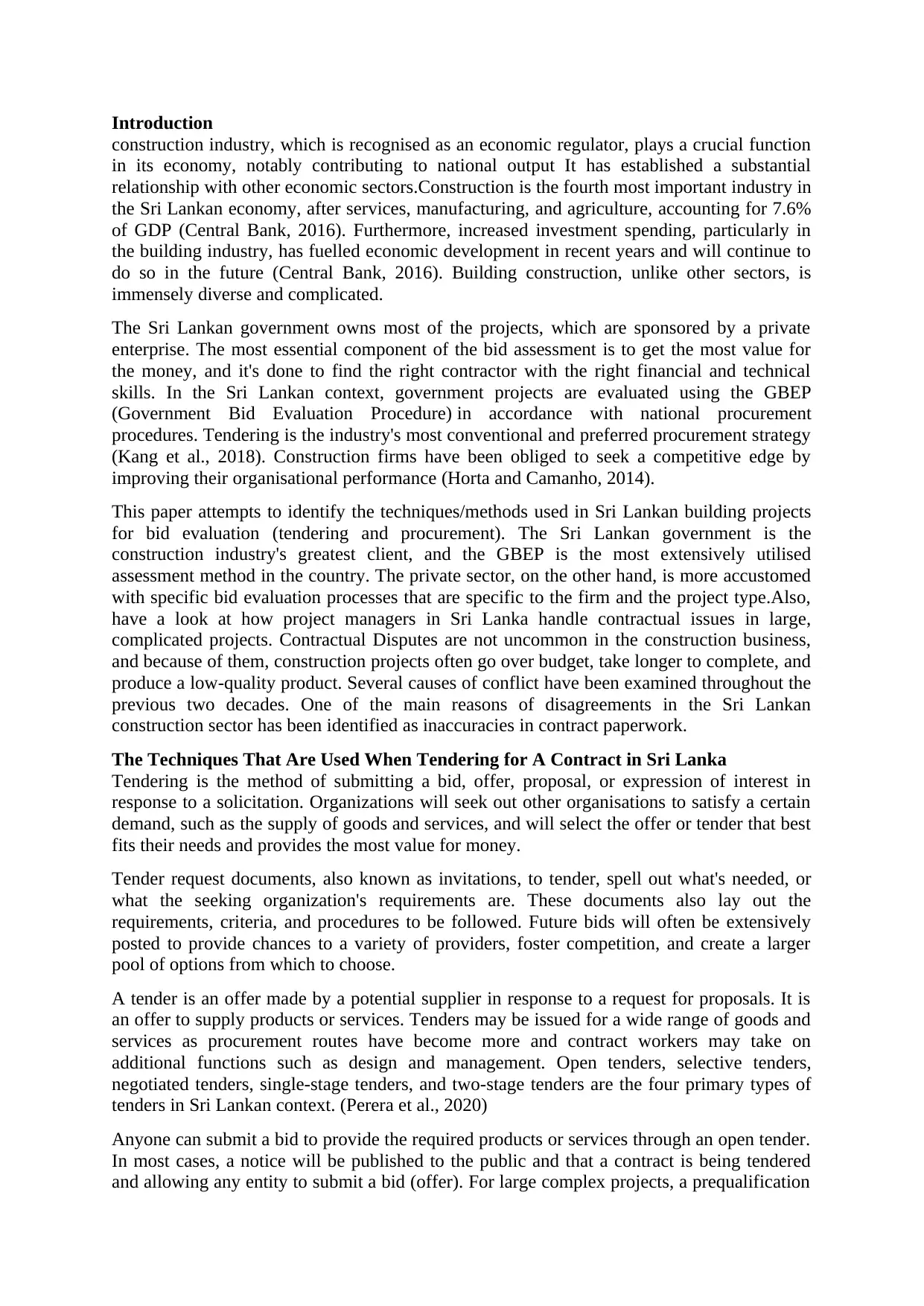
Introduction
construction industry, which is recognised as an economic regulator, plays a crucial function
in its economy, notably contributing to national output It has established a substantial
relationship with other economic sectors.Construction is the fourth most important industry in
the Sri Lankan economy, after services, manufacturing, and agriculture, accounting for 7.6%
of GDP (Central Bank, 2016). Furthermore, increased investment spending, particularly in
the building industry, has fuelled economic development in recent years and will continue to
do so in the future (Central Bank, 2016). Building construction, unlike other sectors, is
immensely diverse and complicated.
The Sri Lankan government owns most of the projects, which are sponsored by a private
enterprise. The most essential component of the bid assessment is to get the most value for
the money, and it's done to find the right contractor with the right financial and technical
skills. In the Sri Lankan context, government projects are evaluated using the GBEP
(Government Bid Evaluation Procedure) in accordance with national procurement
procedures. Tendering is the industry's most conventional and preferred procurement strategy
(Kang et al., 2018). Construction firms have been obliged to seek a competitive edge by
improving their organisational performance (Horta and Camanho, 2014).
This paper attempts to identify the techniques/methods used in Sri Lankan building projects
for bid evaluation (tendering and procurement). The Sri Lankan government is the
construction industry's greatest client, and the GBEP is the most extensively utilised
assessment method in the country. The private sector, on the other hand, is more accustomed
with specific bid evaluation processes that are specific to the firm and the project type.Also,
have a look at how project managers in Sri Lanka handle contractual issues in large,
complicated projects. Contractual Disputes are not uncommon in the construction business,
and because of them, construction projects often go over budget, take longer to complete, and
produce a low-quality product. Several causes of conflict have been examined throughout the
previous two decades. One of the main reasons of disagreements in the Sri Lankan
construction sector has been identified as inaccuracies in contract paperwork.
The Techniques That Are Used When Tendering for A Contract in Sri Lanka
Tendering is the method of submitting a bid, offer, proposal, or expression of interest in
response to a solicitation. Organizations will seek out other organisations to satisfy a certain
demand, such as the supply of goods and services, and will select the offer or tender that best
fits their needs and provides the most value for money.
Tender request documents, also known as invitations, to tender, spell out what's needed, or
what the seeking organization's requirements are. These documents also lay out the
requirements, criteria, and procedures to be followed. Future bids will often be extensively
posted to provide chances to a variety of providers, foster competition, and create a larger
pool of options from which to choose.
A tender is an offer made by a potential supplier in response to a request for proposals. It is
an offer to supply products or services. Tenders may be issued for a wide range of goods and
services as procurement routes have become more and contract workers may take on
additional functions such as design and management. Open tenders, selective tenders,
negotiated tenders, single-stage tenders, and two-stage tenders are the four primary types of
tenders in Sri Lankan context. (Perera et al., 2020)
Anyone can submit a bid to provide the required products or services through an open tender.
In most cases, a notice will be published to the public and that a contract is being tendered
and allowing any entity to submit a bid (offer). For large complex projects, a prequalification
construction industry, which is recognised as an economic regulator, plays a crucial function
in its economy, notably contributing to national output It has established a substantial
relationship with other economic sectors.Construction is the fourth most important industry in
the Sri Lankan economy, after services, manufacturing, and agriculture, accounting for 7.6%
of GDP (Central Bank, 2016). Furthermore, increased investment spending, particularly in
the building industry, has fuelled economic development in recent years and will continue to
do so in the future (Central Bank, 2016). Building construction, unlike other sectors, is
immensely diverse and complicated.
The Sri Lankan government owns most of the projects, which are sponsored by a private
enterprise. The most essential component of the bid assessment is to get the most value for
the money, and it's done to find the right contractor with the right financial and technical
skills. In the Sri Lankan context, government projects are evaluated using the GBEP
(Government Bid Evaluation Procedure) in accordance with national procurement
procedures. Tendering is the industry's most conventional and preferred procurement strategy
(Kang et al., 2018). Construction firms have been obliged to seek a competitive edge by
improving their organisational performance (Horta and Camanho, 2014).
This paper attempts to identify the techniques/methods used in Sri Lankan building projects
for bid evaluation (tendering and procurement). The Sri Lankan government is the
construction industry's greatest client, and the GBEP is the most extensively utilised
assessment method in the country. The private sector, on the other hand, is more accustomed
with specific bid evaluation processes that are specific to the firm and the project type.Also,
have a look at how project managers in Sri Lanka handle contractual issues in large,
complicated projects. Contractual Disputes are not uncommon in the construction business,
and because of them, construction projects often go over budget, take longer to complete, and
produce a low-quality product. Several causes of conflict have been examined throughout the
previous two decades. One of the main reasons of disagreements in the Sri Lankan
construction sector has been identified as inaccuracies in contract paperwork.
The Techniques That Are Used When Tendering for A Contract in Sri Lanka
Tendering is the method of submitting a bid, offer, proposal, or expression of interest in
response to a solicitation. Organizations will seek out other organisations to satisfy a certain
demand, such as the supply of goods and services, and will select the offer or tender that best
fits their needs and provides the most value for money.
Tender request documents, also known as invitations, to tender, spell out what's needed, or
what the seeking organization's requirements are. These documents also lay out the
requirements, criteria, and procedures to be followed. Future bids will often be extensively
posted to provide chances to a variety of providers, foster competition, and create a larger
pool of options from which to choose.
A tender is an offer made by a potential supplier in response to a request for proposals. It is
an offer to supply products or services. Tenders may be issued for a wide range of goods and
services as procurement routes have become more and contract workers may take on
additional functions such as design and management. Open tenders, selective tenders,
negotiated tenders, single-stage tenders, and two-stage tenders are the four primary types of
tenders in Sri Lankan context. (Perera et al., 2020)
Anyone can submit a bid to provide the required products or services through an open tender.
In most cases, a notice will be published to the public and that a contract is being tendered
and allowing any entity to submit a bid (offer). For large complex projects, a prequalification
⊘ This is a preview!⊘
Do you want full access?
Subscribe today to unlock all pages.

Trusted by 1+ million students worldwide
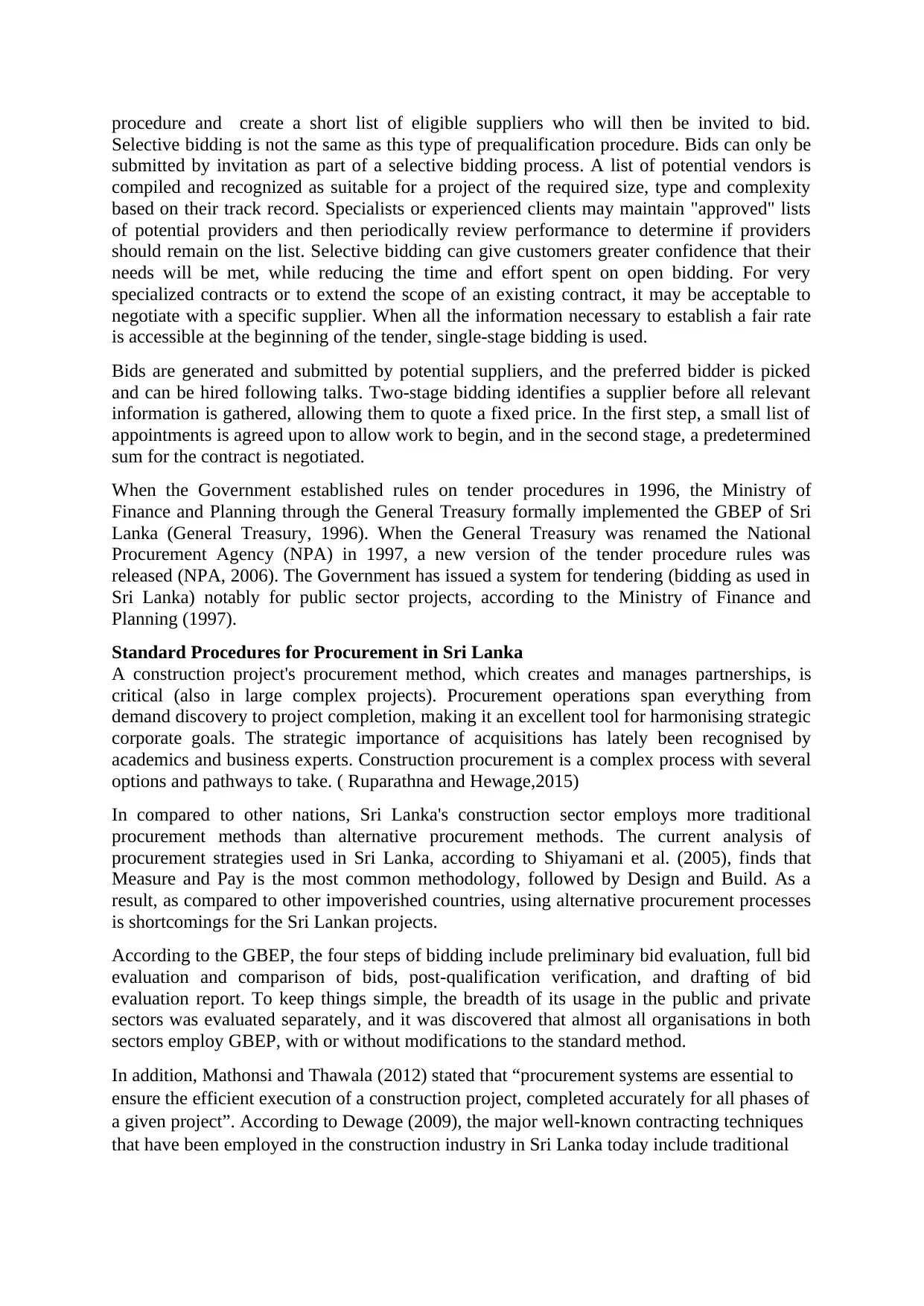
procedure and create a short list of eligible suppliers who will then be invited to bid.
Selective bidding is not the same as this type of prequalification procedure. Bids can only be
submitted by invitation as part of a selective bidding process. A list of potential vendors is
compiled and recognized as suitable for a project of the required size, type and complexity
based on their track record. Specialists or experienced clients may maintain "approved" lists
of potential providers and then periodically review performance to determine if providers
should remain on the list. Selective bidding can give customers greater confidence that their
needs will be met, while reducing the time and effort spent on open bidding. For very
specialized contracts or to extend the scope of an existing contract, it may be acceptable to
negotiate with a specific supplier. When all the information necessary to establish a fair rate
is accessible at the beginning of the tender, single-stage bidding is used.
Bids are generated and submitted by potential suppliers, and the preferred bidder is picked
and can be hired following talks. Two-stage bidding identifies a supplier before all relevant
information is gathered, allowing them to quote a fixed price. In the first step, a small list of
appointments is agreed upon to allow work to begin, and in the second stage, a predetermined
sum for the contract is negotiated.
When the Government established rules on tender procedures in 1996, the Ministry of
Finance and Planning through the General Treasury formally implemented the GBEP of Sri
Lanka (General Treasury, 1996). When the General Treasury was renamed the National
Procurement Agency (NPA) in 1997, a new version of the tender procedure rules was
released (NPA, 2006). The Government has issued a system for tendering (bidding as used in
Sri Lanka) notably for public sector projects, according to the Ministry of Finance and
Planning (1997).
Standard Procedures for Procurement in Sri Lanka
A construction project's procurement method, which creates and manages partnerships, is
critical (also in large complex projects). Procurement operations span everything from
demand discovery to project completion, making it an excellent tool for harmonising strategic
corporate goals. The strategic importance of acquisitions has lately been recognised by
academics and business experts. Construction procurement is a complex process with several
options and pathways to take. ( Ruparathna and Hewage,2015)
In compared to other nations, Sri Lanka's construction sector employs more traditional
procurement methods than alternative procurement methods. The current analysis of
procurement strategies used in Sri Lanka, according to Shiyamani et al. (2005), finds that
Measure and Pay is the most common methodology, followed by Design and Build. As a
result, as compared to other impoverished countries, using alternative procurement processes
is shortcomings for the Sri Lankan projects.
According to the GBEP, the four steps of bidding include preliminary bid evaluation, full bid
evaluation and comparison of bids, post-qualification verification, and drafting of bid
evaluation report. To keep things simple, the breadth of its usage in the public and private
sectors was evaluated separately, and it was discovered that almost all organisations in both
sectors employ GBEP, with or without modifications to the standard method.
In addition, Mathonsi and Thawala (2012) stated that “procurement systems are essential to
ensure the efficient execution of a construction project, completed accurately for all phases of
a given project”. According to Dewage (2009), the major well-known contracting techniques
that have been employed in the construction industry in Sri Lanka today include traditional
Selective bidding is not the same as this type of prequalification procedure. Bids can only be
submitted by invitation as part of a selective bidding process. A list of potential vendors is
compiled and recognized as suitable for a project of the required size, type and complexity
based on their track record. Specialists or experienced clients may maintain "approved" lists
of potential providers and then periodically review performance to determine if providers
should remain on the list. Selective bidding can give customers greater confidence that their
needs will be met, while reducing the time and effort spent on open bidding. For very
specialized contracts or to extend the scope of an existing contract, it may be acceptable to
negotiate with a specific supplier. When all the information necessary to establish a fair rate
is accessible at the beginning of the tender, single-stage bidding is used.
Bids are generated and submitted by potential suppliers, and the preferred bidder is picked
and can be hired following talks. Two-stage bidding identifies a supplier before all relevant
information is gathered, allowing them to quote a fixed price. In the first step, a small list of
appointments is agreed upon to allow work to begin, and in the second stage, a predetermined
sum for the contract is negotiated.
When the Government established rules on tender procedures in 1996, the Ministry of
Finance and Planning through the General Treasury formally implemented the GBEP of Sri
Lanka (General Treasury, 1996). When the General Treasury was renamed the National
Procurement Agency (NPA) in 1997, a new version of the tender procedure rules was
released (NPA, 2006). The Government has issued a system for tendering (bidding as used in
Sri Lanka) notably for public sector projects, according to the Ministry of Finance and
Planning (1997).
Standard Procedures for Procurement in Sri Lanka
A construction project's procurement method, which creates and manages partnerships, is
critical (also in large complex projects). Procurement operations span everything from
demand discovery to project completion, making it an excellent tool for harmonising strategic
corporate goals. The strategic importance of acquisitions has lately been recognised by
academics and business experts. Construction procurement is a complex process with several
options and pathways to take. ( Ruparathna and Hewage,2015)
In compared to other nations, Sri Lanka's construction sector employs more traditional
procurement methods than alternative procurement methods. The current analysis of
procurement strategies used in Sri Lanka, according to Shiyamani et al. (2005), finds that
Measure and Pay is the most common methodology, followed by Design and Build. As a
result, as compared to other impoverished countries, using alternative procurement processes
is shortcomings for the Sri Lankan projects.
According to the GBEP, the four steps of bidding include preliminary bid evaluation, full bid
evaluation and comparison of bids, post-qualification verification, and drafting of bid
evaluation report. To keep things simple, the breadth of its usage in the public and private
sectors was evaluated separately, and it was discovered that almost all organisations in both
sectors employ GBEP, with or without modifications to the standard method.
In addition, Mathonsi and Thawala (2012) stated that “procurement systems are essential to
ensure the efficient execution of a construction project, completed accurately for all phases of
a given project”. According to Dewage (2009), the major well-known contracting techniques
that have been employed in the construction industry in Sri Lanka today include traditional
Paraphrase This Document
Need a fresh take? Get an instant paraphrase of this document with our AI Paraphraser
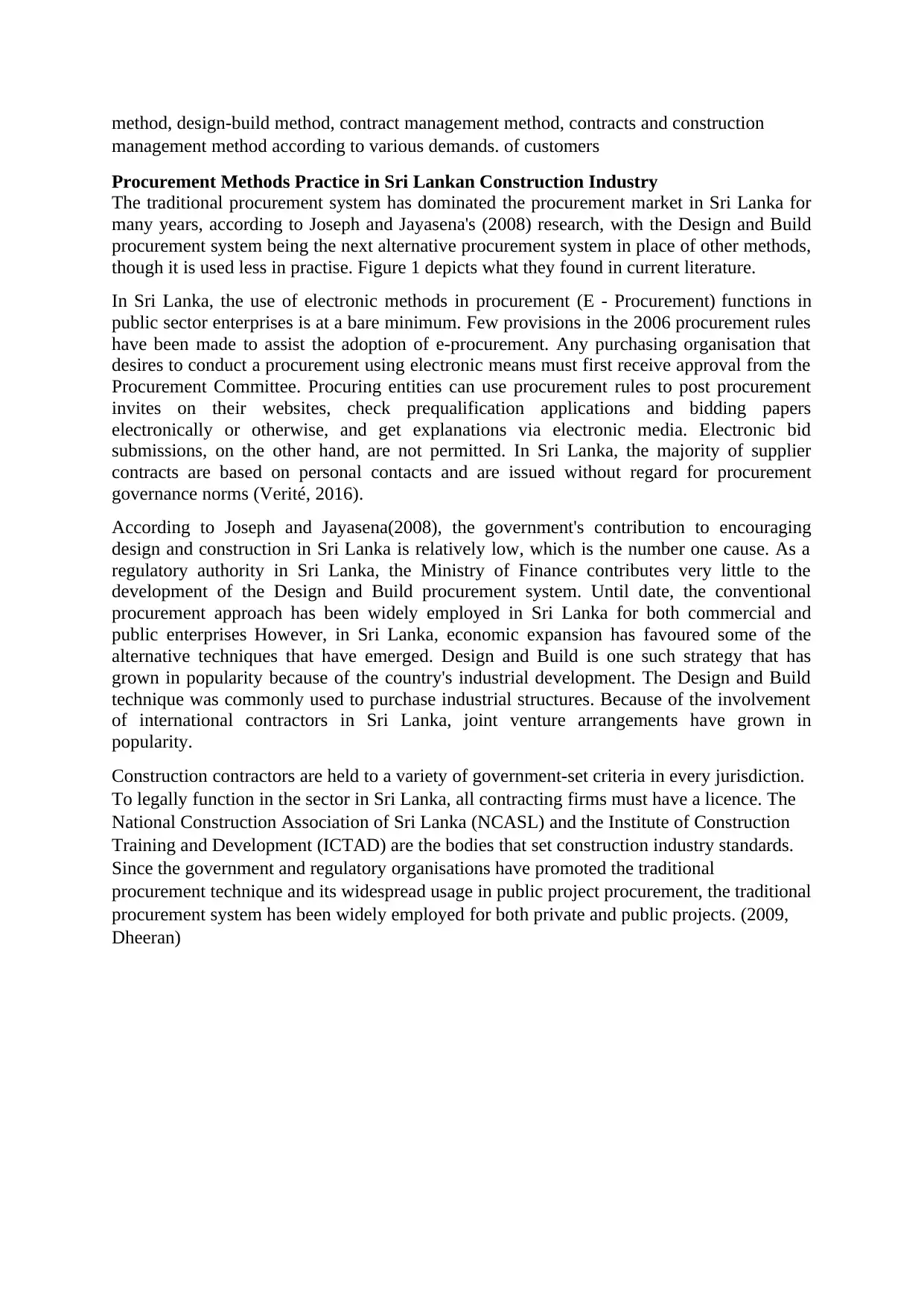
method, design-build method, contract management method, contracts and construction
management method according to various demands. of customers
Procurement Methods Practice in Sri Lankan Construction Industry
The traditional procurement system has dominated the procurement market in Sri Lanka for
many years, according to Joseph and Jayasena's (2008) research, with the Design and Build
procurement system being the next alternative procurement system in place of other methods,
though it is used less in practise. Figure 1 depicts what they found in current literature.
In Sri Lanka, the use of electronic methods in procurement (E - Procurement) functions in
public sector enterprises is at a bare minimum. Few provisions in the 2006 procurement rules
have been made to assist the adoption of e-procurement. Any purchasing organisation that
desires to conduct a procurement using electronic means must first receive approval from the
Procurement Committee. Procuring entities can use procurement rules to post procurement
invites on their websites, check prequalification applications and bidding papers
electronically or otherwise, and get explanations via electronic media. Electronic bid
submissions, on the other hand, are not permitted. In Sri Lanka, the majority of supplier
contracts are based on personal contacts and are issued without regard for procurement
governance norms (Verité, 2016).
According to Joseph and Jayasena(2008), the government's contribution to encouraging
design and construction in Sri Lanka is relatively low, which is the number one cause. As a
regulatory authority in Sri Lanka, the Ministry of Finance contributes very little to the
development of the Design and Build procurement system. Until date, the conventional
procurement approach has been widely employed in Sri Lanka for both commercial and
public enterprises However, in Sri Lanka, economic expansion has favoured some of the
alternative techniques that have emerged. Design and Build is one such strategy that has
grown in popularity because of the country's industrial development. The Design and Build
technique was commonly used to purchase industrial structures. Because of the involvement
of international contractors in Sri Lanka, joint venture arrangements have grown in
popularity.
Construction contractors are held to a variety of government-set criteria in every jurisdiction.
To legally function in the sector in Sri Lanka, all contracting firms must have a licence. The
National Construction Association of Sri Lanka (NCASL) and the Institute of Construction
Training and Development (ICTAD) are the bodies that set construction industry standards.
Since the government and regulatory organisations have promoted the traditional
procurement technique and its widespread usage in public project procurement, the traditional
procurement system has been widely employed for both private and public projects. (2009,
Dheeran)
management method according to various demands. of customers
Procurement Methods Practice in Sri Lankan Construction Industry
The traditional procurement system has dominated the procurement market in Sri Lanka for
many years, according to Joseph and Jayasena's (2008) research, with the Design and Build
procurement system being the next alternative procurement system in place of other methods,
though it is used less in practise. Figure 1 depicts what they found in current literature.
In Sri Lanka, the use of electronic methods in procurement (E - Procurement) functions in
public sector enterprises is at a bare minimum. Few provisions in the 2006 procurement rules
have been made to assist the adoption of e-procurement. Any purchasing organisation that
desires to conduct a procurement using electronic means must first receive approval from the
Procurement Committee. Procuring entities can use procurement rules to post procurement
invites on their websites, check prequalification applications and bidding papers
electronically or otherwise, and get explanations via electronic media. Electronic bid
submissions, on the other hand, are not permitted. In Sri Lanka, the majority of supplier
contracts are based on personal contacts and are issued without regard for procurement
governance norms (Verité, 2016).
According to Joseph and Jayasena(2008), the government's contribution to encouraging
design and construction in Sri Lanka is relatively low, which is the number one cause. As a
regulatory authority in Sri Lanka, the Ministry of Finance contributes very little to the
development of the Design and Build procurement system. Until date, the conventional
procurement approach has been widely employed in Sri Lanka for both commercial and
public enterprises However, in Sri Lanka, economic expansion has favoured some of the
alternative techniques that have emerged. Design and Build is one such strategy that has
grown in popularity because of the country's industrial development. The Design and Build
technique was commonly used to purchase industrial structures. Because of the involvement
of international contractors in Sri Lanka, joint venture arrangements have grown in
popularity.
Construction contractors are held to a variety of government-set criteria in every jurisdiction.
To legally function in the sector in Sri Lanka, all contracting firms must have a licence. The
National Construction Association of Sri Lanka (NCASL) and the Institute of Construction
Training and Development (ICTAD) are the bodies that set construction industry standards.
Since the government and regulatory organisations have promoted the traditional
procurement technique and its widespread usage in public project procurement, the traditional
procurement system has been widely employed for both private and public projects. (2009,
Dheeran)
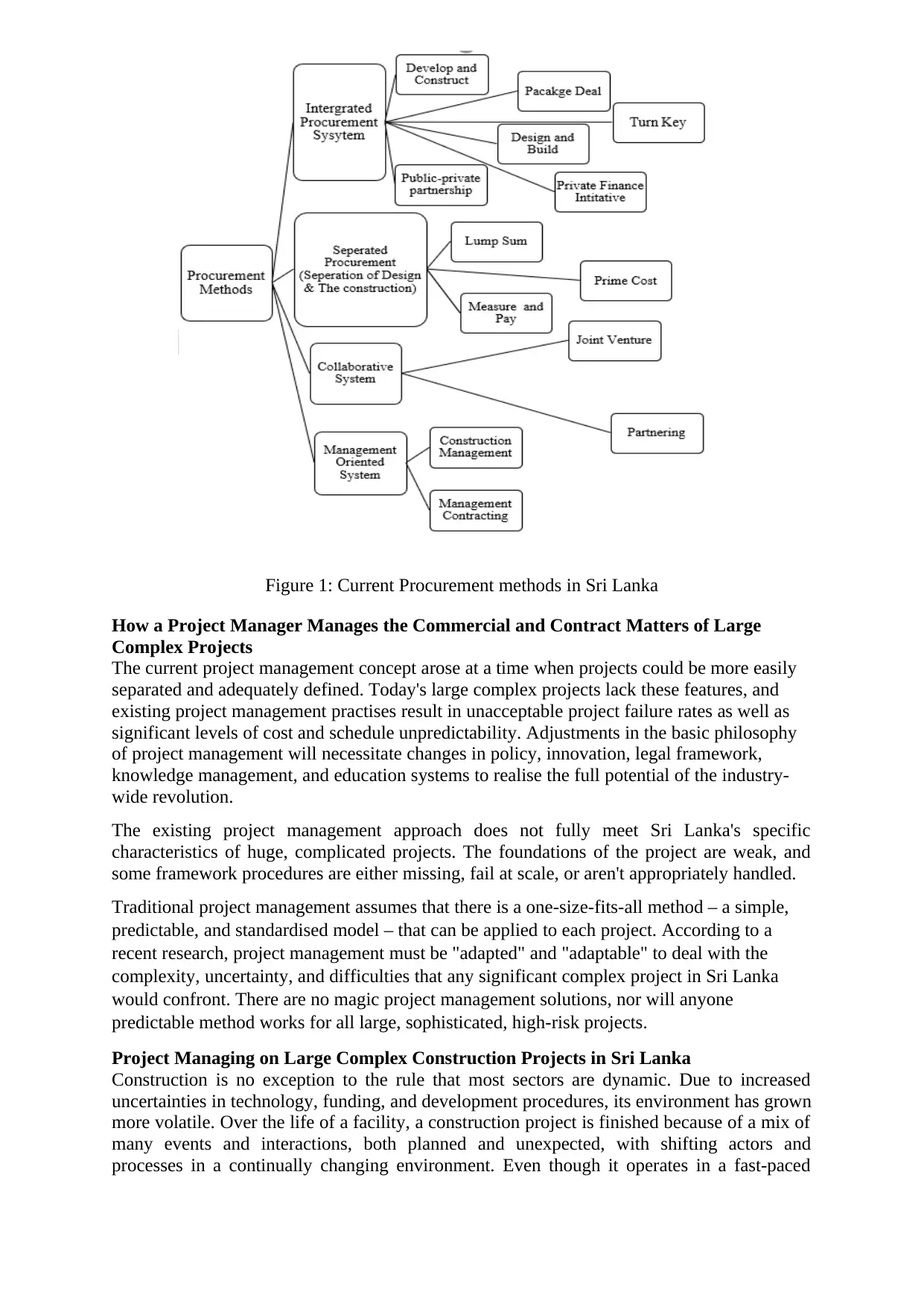
Figure 1: Current Procurement methods in Sri Lanka
How a Project Manager Manages the Commercial and Contract Matters of Large
Complex Projects
The current project management concept arose at a time when projects could be more easily
separated and adequately defined. Today's large complex projects lack these features, and
existing project management practises result in unacceptable project failure rates as well as
significant levels of cost and schedule unpredictability. Adjustments in the basic philosophy
of project management will necessitate changes in policy, innovation, legal framework,
knowledge management, and education systems to realise the full potential of the industry-
wide revolution.
The existing project management approach does not fully meet Sri Lanka's specific
characteristics of huge, complicated projects. The foundations of the project are weak, and
some framework procedures are either missing, fail at scale, or aren't appropriately handled.
Traditional project management assumes that there is a one-size-fits-all method – a simple,
predictable, and standardised model – that can be applied to each project. According to a
recent research, project management must be "adapted" and "adaptable" to deal with the
complexity, uncertainty, and difficulties that any significant complex project in Sri Lanka
would confront. There are no magic project management solutions, nor will anyone
predictable method works for all large, sophisticated, high-risk projects.
Project Managing on Large Complex Construction Projects in Sri Lanka
Construction is no exception to the rule that most sectors are dynamic. Due to increased
uncertainties in technology, funding, and development procedures, its environment has grown
more volatile. Over the life of a facility, a construction project is finished because of a mix of
many events and interactions, both planned and unexpected, with shifting actors and
processes in a continually changing environment. Even though it operates in a fast-paced
How a Project Manager Manages the Commercial and Contract Matters of Large
Complex Projects
The current project management concept arose at a time when projects could be more easily
separated and adequately defined. Today's large complex projects lack these features, and
existing project management practises result in unacceptable project failure rates as well as
significant levels of cost and schedule unpredictability. Adjustments in the basic philosophy
of project management will necessitate changes in policy, innovation, legal framework,
knowledge management, and education systems to realise the full potential of the industry-
wide revolution.
The existing project management approach does not fully meet Sri Lanka's specific
characteristics of huge, complicated projects. The foundations of the project are weak, and
some framework procedures are either missing, fail at scale, or aren't appropriately handled.
Traditional project management assumes that there is a one-size-fits-all method – a simple,
predictable, and standardised model – that can be applied to each project. According to a
recent research, project management must be "adapted" and "adaptable" to deal with the
complexity, uncertainty, and difficulties that any significant complex project in Sri Lanka
would confront. There are no magic project management solutions, nor will anyone
predictable method works for all large, sophisticated, high-risk projects.
Project Managing on Large Complex Construction Projects in Sri Lanka
Construction is no exception to the rule that most sectors are dynamic. Due to increased
uncertainties in technology, funding, and development procedures, its environment has grown
more volatile. Over the life of a facility, a construction project is finished because of a mix of
many events and interactions, both planned and unexpected, with shifting actors and
processes in a continually changing environment. Even though it operates in a fast-paced
⊘ This is a preview!⊘
Do you want full access?
Subscribe today to unlock all pages.

Trusted by 1+ million students worldwide
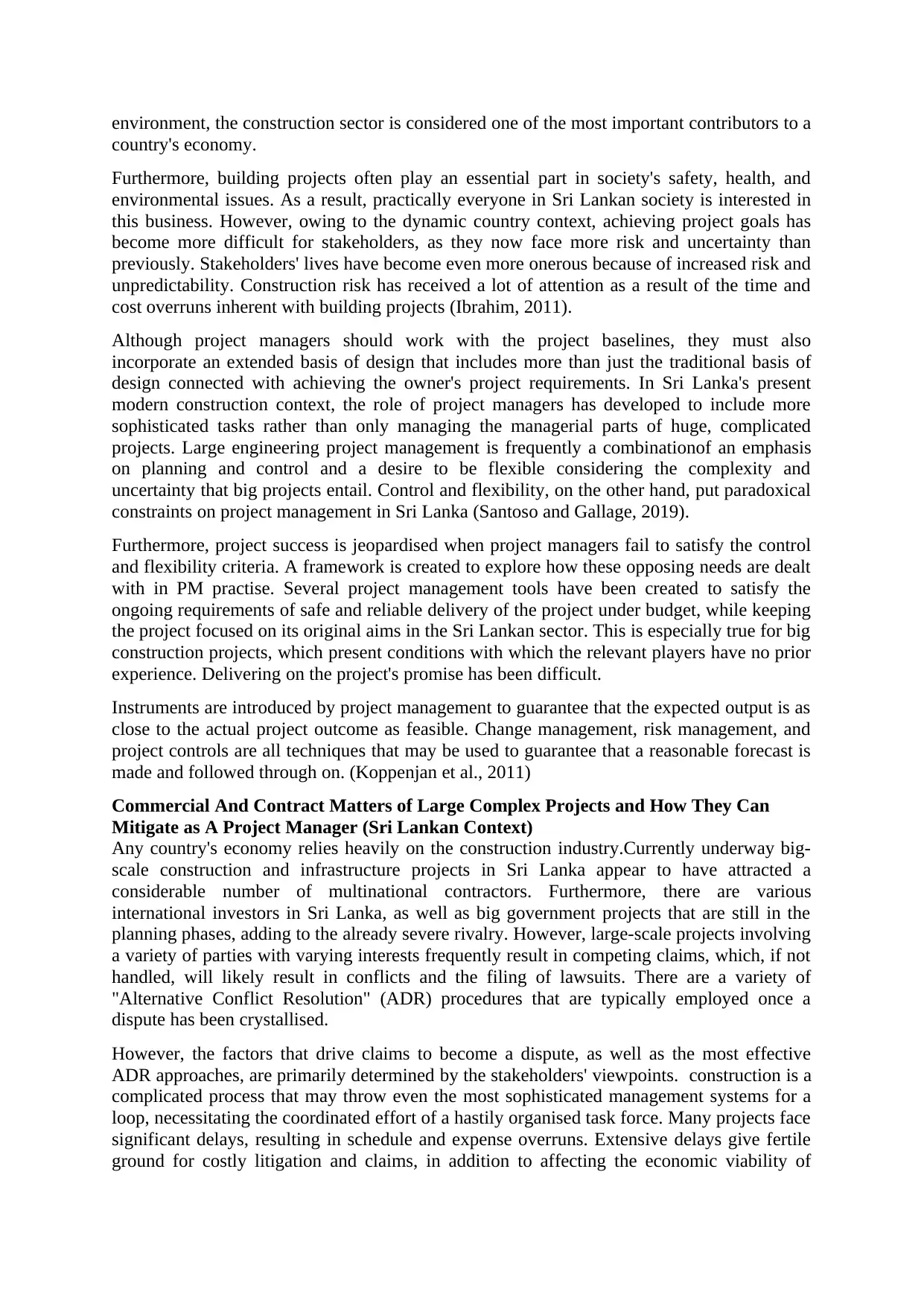
environment, the construction sector is considered one of the most important contributors to a
country's economy.
Furthermore, building projects often play an essential part in society's safety, health, and
environmental issues. As a result, practically everyone in Sri Lankan society is interested in
this business. However, owing to the dynamic country context, achieving project goals has
become more difficult for stakeholders, as they now face more risk and uncertainty than
previously. Stakeholders' lives have become even more onerous because of increased risk and
unpredictability. Construction risk has received a lot of attention as a result of the time and
cost overruns inherent with building projects (Ibrahim, 2011).
Although project managers should work with the project baselines, they must also
incorporate an extended basis of design that includes more than just the traditional basis of
design connected with achieving the owner's project requirements. In Sri Lanka's present
modern construction context, the role of project managers has developed to include more
sophisticated tasks rather than only managing the managerial parts of huge, complicated
projects. Large engineering project management is frequently a combinationof an emphasis
on planning and control and a desire to be flexible considering the complexity and
uncertainty that big projects entail. Control and flexibility, on the other hand, put paradoxical
constraints on project management in Sri Lanka (Santoso and Gallage, 2019).
Furthermore, project success is jeopardised when project managers fail to satisfy the control
and flexibility criteria. A framework is created to explore how these opposing needs are dealt
with in PM practise. Several project management tools have been created to satisfy the
ongoing requirements of safe and reliable delivery of the project under budget, while keeping
the project focused on its original aims in the Sri Lankan sector. This is especially true for big
construction projects, which present conditions with which the relevant players have no prior
experience. Delivering on the project's promise has been difficult.
Instruments are introduced by project management to guarantee that the expected output is as
close to the actual project outcome as feasible. Change management, risk management, and
project controls are all techniques that may be used to guarantee that a reasonable forecast is
made and followed through on. (Koppenjan et al., 2011)
Commercial And Contract Matters of Large Complex Projects and How They Can
Mitigate as A Project Manager (Sri Lankan Context)
Any country's economy relies heavily on the construction industry.Currently underway big-
scale construction and infrastructure projects in Sri Lanka appear to have attracted a
considerable number of multinational contractors. Furthermore, there are various
international investors in Sri Lanka, as well as big government projects that are still in the
planning phases, adding to the already severe rivalry. However, large-scale projects involving
a variety of parties with varying interests frequently result in competing claims, which, if not
handled, will likely result in conflicts and the filing of lawsuits. There are a variety of
"Alternative Conflict Resolution" (ADR) procedures that are typically employed once a
dispute has been crystallised.
However, the factors that drive claims to become a dispute, as well as the most effective
ADR approaches, are primarily determined by the stakeholders' viewpoints. construction is a
complicated process that may throw even the most sophisticated management systems for a
loop, necessitating the coordinated effort of a hastily organised task force. Many projects face
significant delays, resulting in schedule and expense overruns. Extensive delays give fertile
ground for costly litigation and claims, in addition to affecting the economic viability of
country's economy.
Furthermore, building projects often play an essential part in society's safety, health, and
environmental issues. As a result, practically everyone in Sri Lankan society is interested in
this business. However, owing to the dynamic country context, achieving project goals has
become more difficult for stakeholders, as they now face more risk and uncertainty than
previously. Stakeholders' lives have become even more onerous because of increased risk and
unpredictability. Construction risk has received a lot of attention as a result of the time and
cost overruns inherent with building projects (Ibrahim, 2011).
Although project managers should work with the project baselines, they must also
incorporate an extended basis of design that includes more than just the traditional basis of
design connected with achieving the owner's project requirements. In Sri Lanka's present
modern construction context, the role of project managers has developed to include more
sophisticated tasks rather than only managing the managerial parts of huge, complicated
projects. Large engineering project management is frequently a combinationof an emphasis
on planning and control and a desire to be flexible considering the complexity and
uncertainty that big projects entail. Control and flexibility, on the other hand, put paradoxical
constraints on project management in Sri Lanka (Santoso and Gallage, 2019).
Furthermore, project success is jeopardised when project managers fail to satisfy the control
and flexibility criteria. A framework is created to explore how these opposing needs are dealt
with in PM practise. Several project management tools have been created to satisfy the
ongoing requirements of safe and reliable delivery of the project under budget, while keeping
the project focused on its original aims in the Sri Lankan sector. This is especially true for big
construction projects, which present conditions with which the relevant players have no prior
experience. Delivering on the project's promise has been difficult.
Instruments are introduced by project management to guarantee that the expected output is as
close to the actual project outcome as feasible. Change management, risk management, and
project controls are all techniques that may be used to guarantee that a reasonable forecast is
made and followed through on. (Koppenjan et al., 2011)
Commercial And Contract Matters of Large Complex Projects and How They Can
Mitigate as A Project Manager (Sri Lankan Context)
Any country's economy relies heavily on the construction industry.Currently underway big-
scale construction and infrastructure projects in Sri Lanka appear to have attracted a
considerable number of multinational contractors. Furthermore, there are various
international investors in Sri Lanka, as well as big government projects that are still in the
planning phases, adding to the already severe rivalry. However, large-scale projects involving
a variety of parties with varying interests frequently result in competing claims, which, if not
handled, will likely result in conflicts and the filing of lawsuits. There are a variety of
"Alternative Conflict Resolution" (ADR) procedures that are typically employed once a
dispute has been crystallised.
However, the factors that drive claims to become a dispute, as well as the most effective
ADR approaches, are primarily determined by the stakeholders' viewpoints. construction is a
complicated process that may throw even the most sophisticated management systems for a
loop, necessitating the coordinated effort of a hastily organised task force. Many projects face
significant delays, resulting in schedule and expense overruns. Extensive delays give fertile
ground for costly litigation and claims, in addition to affecting the economic viability of
Paraphrase This Document
Need a fresh take? Get an instant paraphrase of this document with our AI Paraphraser
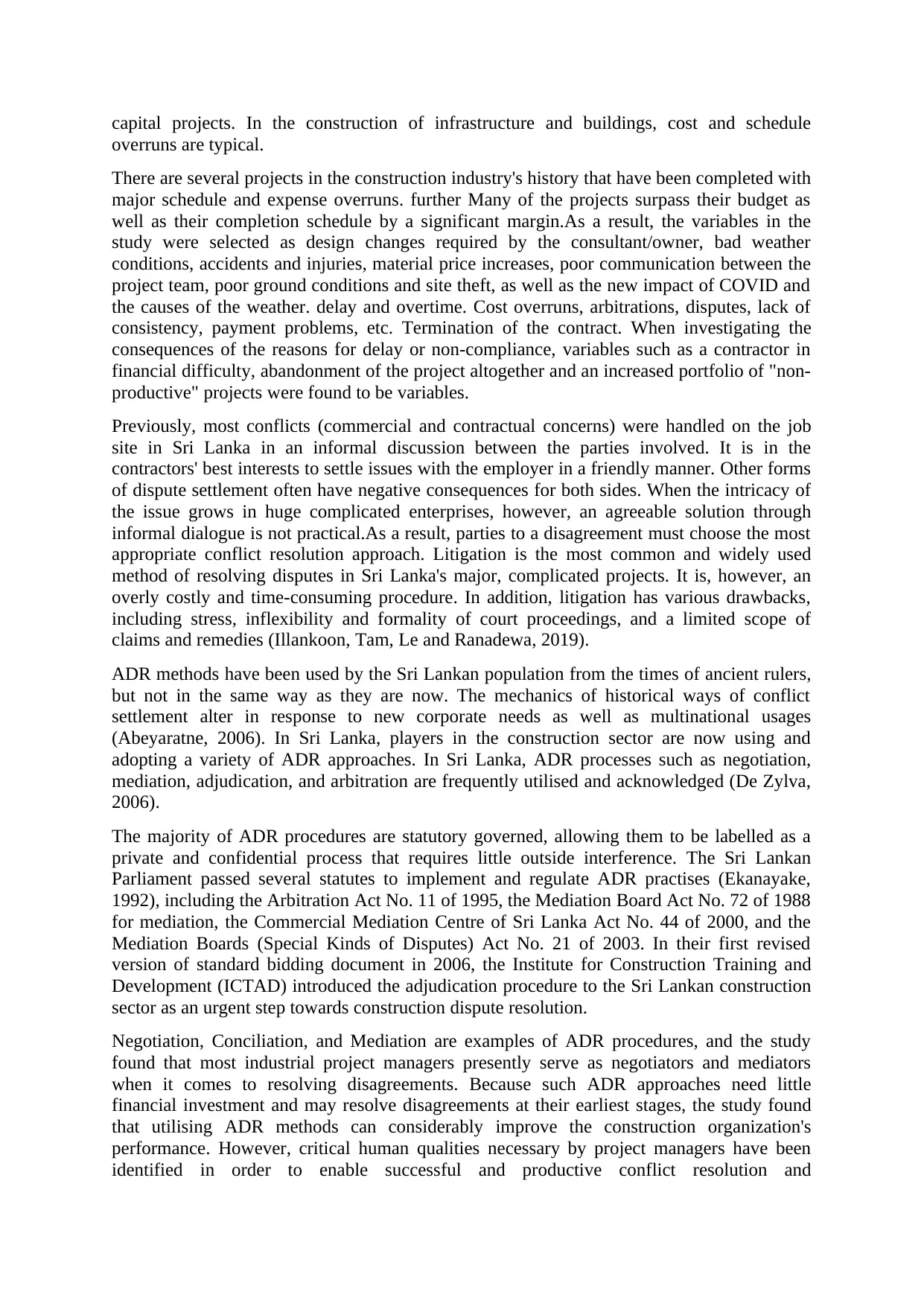
capital projects. In the construction of infrastructure and buildings, cost and schedule
overruns are typical.
There are several projects in the construction industry's history that have been completed with
major schedule and expense overruns. further Many of the projects surpass their budget as
well as their completion schedule by a significant margin.As a result, the variables in the
study were selected as design changes required by the consultant/owner, bad weather
conditions, accidents and injuries, material price increases, poor communication between the
project team, poor ground conditions and site theft, as well as the new impact of COVID and
the causes of the weather. delay and overtime. Cost overruns, arbitrations, disputes, lack of
consistency, payment problems, etc. Termination of the contract. When investigating the
consequences of the reasons for delay or non-compliance, variables such as a contractor in
financial difficulty, abandonment of the project altogether and an increased portfolio of "non-
productive" projects were found to be variables.
Previously, most conflicts (commercial and contractual concerns) were handled on the job
site in Sri Lanka in an informal discussion between the parties involved. It is in the
contractors' best interests to settle issues with the employer in a friendly manner. Other forms
of dispute settlement often have negative consequences for both sides. When the intricacy of
the issue grows in huge complicated enterprises, however, an agreeable solution through
informal dialogue is not practical.As a result, parties to a disagreement must choose the most
appropriate conflict resolution approach. Litigation is the most common and widely used
method of resolving disputes in Sri Lanka's major, complicated projects. It is, however, an
overly costly and time-consuming procedure. In addition, litigation has various drawbacks,
including stress, inflexibility and formality of court proceedings, and a limited scope of
claims and remedies (Illankoon, Tam, Le and Ranadewa, 2019).
ADR methods have been used by the Sri Lankan population from the times of ancient rulers,
but not in the same way as they are now. The mechanics of historical ways of conflict
settlement alter in response to new corporate needs as well as multinational usages
(Abeyaratne, 2006). In Sri Lanka, players in the construction sector are now using and
adopting a variety of ADR approaches. In Sri Lanka, ADR processes such as negotiation,
mediation, adjudication, and arbitration are frequently utilised and acknowledged (De Zylva,
2006).
The majority of ADR procedures are statutory governed, allowing them to be labelled as a
private and confidential process that requires little outside interference. The Sri Lankan
Parliament passed several statutes to implement and regulate ADR practises (Ekanayake,
1992), including the Arbitration Act No. 11 of 1995, the Mediation Board Act No. 72 of 1988
for mediation, the Commercial Mediation Centre of Sri Lanka Act No. 44 of 2000, and the
Mediation Boards (Special Kinds of Disputes) Act No. 21 of 2003. In their first revised
version of standard bidding document in 2006, the Institute for Construction Training and
Development (ICTAD) introduced the adjudication procedure to the Sri Lankan construction
sector as an urgent step towards construction dispute resolution.
Negotiation, Conciliation, and Mediation are examples of ADR procedures, and the study
found that most industrial project managers presently serve as negotiators and mediators
when it comes to resolving disagreements. Because such ADR approaches need little
financial investment and may resolve disagreements at their earliest stages, the study found
that utilising ADR methods can considerably improve the construction organization's
performance. However, critical human qualities necessary by project managers have been
identified in order to enable successful and productive conflict resolution and
overruns are typical.
There are several projects in the construction industry's history that have been completed with
major schedule and expense overruns. further Many of the projects surpass their budget as
well as their completion schedule by a significant margin.As a result, the variables in the
study were selected as design changes required by the consultant/owner, bad weather
conditions, accidents and injuries, material price increases, poor communication between the
project team, poor ground conditions and site theft, as well as the new impact of COVID and
the causes of the weather. delay and overtime. Cost overruns, arbitrations, disputes, lack of
consistency, payment problems, etc. Termination of the contract. When investigating the
consequences of the reasons for delay or non-compliance, variables such as a contractor in
financial difficulty, abandonment of the project altogether and an increased portfolio of "non-
productive" projects were found to be variables.
Previously, most conflicts (commercial and contractual concerns) were handled on the job
site in Sri Lanka in an informal discussion between the parties involved. It is in the
contractors' best interests to settle issues with the employer in a friendly manner. Other forms
of dispute settlement often have negative consequences for both sides. When the intricacy of
the issue grows in huge complicated enterprises, however, an agreeable solution through
informal dialogue is not practical.As a result, parties to a disagreement must choose the most
appropriate conflict resolution approach. Litigation is the most common and widely used
method of resolving disputes in Sri Lanka's major, complicated projects. It is, however, an
overly costly and time-consuming procedure. In addition, litigation has various drawbacks,
including stress, inflexibility and formality of court proceedings, and a limited scope of
claims and remedies (Illankoon, Tam, Le and Ranadewa, 2019).
ADR methods have been used by the Sri Lankan population from the times of ancient rulers,
but not in the same way as they are now. The mechanics of historical ways of conflict
settlement alter in response to new corporate needs as well as multinational usages
(Abeyaratne, 2006). In Sri Lanka, players in the construction sector are now using and
adopting a variety of ADR approaches. In Sri Lanka, ADR processes such as negotiation,
mediation, adjudication, and arbitration are frequently utilised and acknowledged (De Zylva,
2006).
The majority of ADR procedures are statutory governed, allowing them to be labelled as a
private and confidential process that requires little outside interference. The Sri Lankan
Parliament passed several statutes to implement and regulate ADR practises (Ekanayake,
1992), including the Arbitration Act No. 11 of 1995, the Mediation Board Act No. 72 of 1988
for mediation, the Commercial Mediation Centre of Sri Lanka Act No. 44 of 2000, and the
Mediation Boards (Special Kinds of Disputes) Act No. 21 of 2003. In their first revised
version of standard bidding document in 2006, the Institute for Construction Training and
Development (ICTAD) introduced the adjudication procedure to the Sri Lankan construction
sector as an urgent step towards construction dispute resolution.
Negotiation, Conciliation, and Mediation are examples of ADR procedures, and the study
found that most industrial project managers presently serve as negotiators and mediators
when it comes to resolving disagreements. Because such ADR approaches need little
financial investment and may resolve disagreements at their earliest stages, the study found
that utilising ADR methods can considerably improve the construction organization's
performance. However, critical human qualities necessary by project managers have been
identified in order to enable successful and productive conflict resolution and
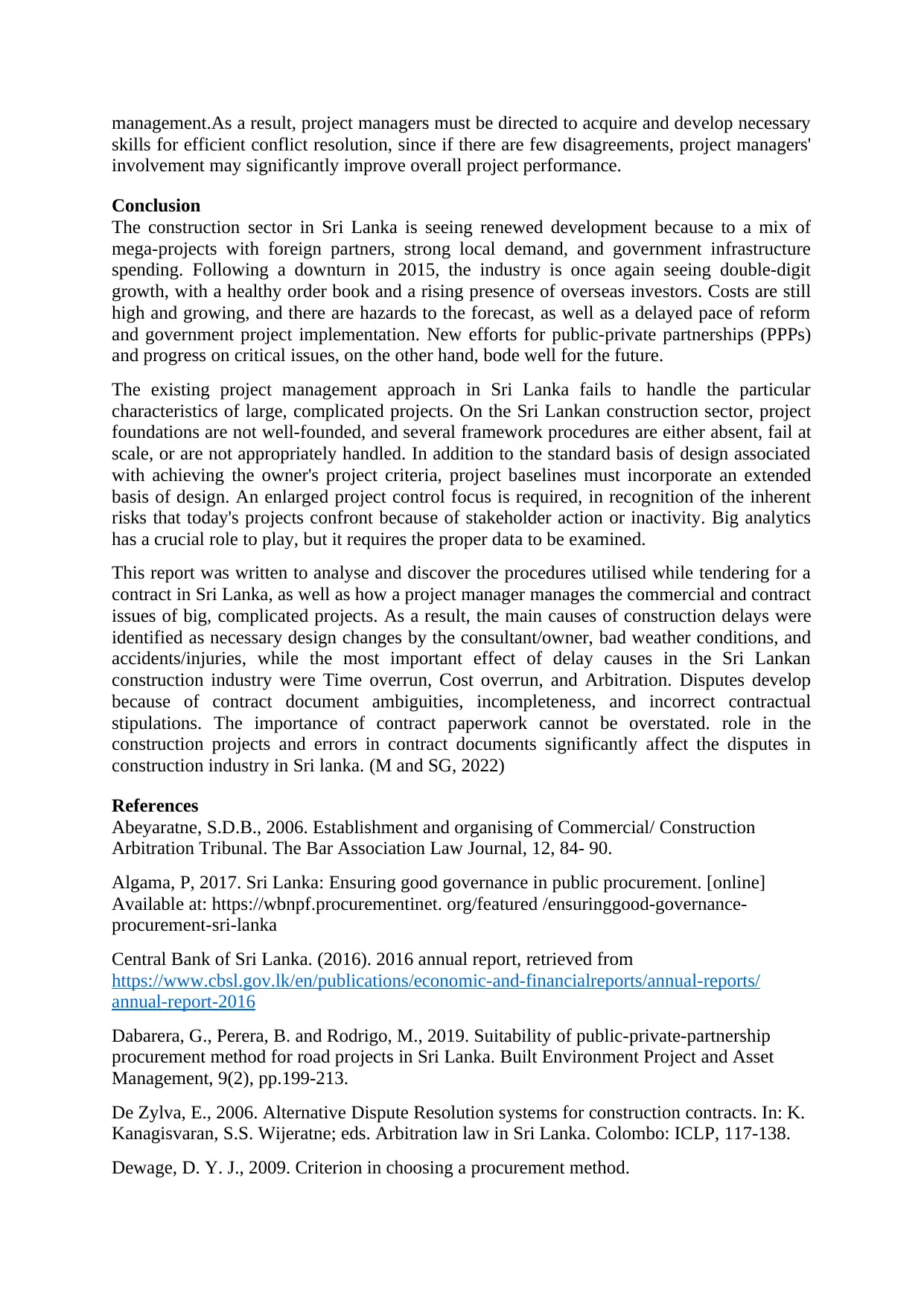
management.As a result, project managers must be directed to acquire and develop necessary
skills for efficient conflict resolution, since if there are few disagreements, project managers'
involvement may significantly improve overall project performance.
Conclusion
The construction sector in Sri Lanka is seeing renewed development because to a mix of
mega-projects with foreign partners, strong local demand, and government infrastructure
spending. Following a downturn in 2015, the industry is once again seeing double-digit
growth, with a healthy order book and a rising presence of overseas investors. Costs are still
high and growing, and there are hazards to the forecast, as well as a delayed pace of reform
and government project implementation. New efforts for public-private partnerships (PPPs)
and progress on critical issues, on the other hand, bode well for the future.
The existing project management approach in Sri Lanka fails to handle the particular
characteristics of large, complicated projects. On the Sri Lankan construction sector, project
foundations are not well-founded, and several framework procedures are either absent, fail at
scale, or are not appropriately handled. In addition to the standard basis of design associated
with achieving the owner's project criteria, project baselines must incorporate an extended
basis of design. An enlarged project control focus is required, in recognition of the inherent
risks that today's projects confront because of stakeholder action or inactivity. Big analytics
has a crucial role to play, but it requires the proper data to be examined.
This report was written to analyse and discover the procedures utilised while tendering for a
contract in Sri Lanka, as well as how a project manager manages the commercial and contract
issues of big, complicated projects. As a result, the main causes of construction delays were
identified as necessary design changes by the consultant/owner, bad weather conditions, and
accidents/injuries, while the most important effect of delay causes in the Sri Lankan
construction industry were Time overrun, Cost overrun, and Arbitration. Disputes develop
because of contract document ambiguities, incompleteness, and incorrect contractual
stipulations. The importance of contract paperwork cannot be overstated. role in the
construction projects and errors in contract documents significantly affect the disputes in
construction industry in Sri lanka. (M and SG, 2022)
References
Abeyaratne, S.D.B., 2006. Establishment and organising of Commercial/ Construction
Arbitration Tribunal. The Bar Association Law Journal, 12, 84- 90.
Algama, P, 2017. Sri Lanka: Ensuring good governance in public procurement. [online]
Available at: https://wbnpf.procurementinet. org/featured /ensuringgood-governance-
procurement-sri-lanka
Central Bank of Sri Lanka. (2016). 2016 annual report, retrieved from
https://www.cbsl.gov.lk/en/publications/economic-and-financialreports/annual-reports/
annual-report-2016
Dabarera, G., Perera, B. and Rodrigo, M., 2019. Suitability of public-private-partnership
procurement method for road projects in Sri Lanka. Built Environment Project and Asset
Management, 9(2), pp.199-213.
De Zylva, E., 2006. Alternative Dispute Resolution systems for construction contracts. In: K.
Kanagisvaran, S.S. Wijeratne; eds. Arbitration law in Sri Lanka. Colombo: ICLP, 117-138.
Dewage, D. Y. J., 2009. Criterion in choosing a procurement method.
skills for efficient conflict resolution, since if there are few disagreements, project managers'
involvement may significantly improve overall project performance.
Conclusion
The construction sector in Sri Lanka is seeing renewed development because to a mix of
mega-projects with foreign partners, strong local demand, and government infrastructure
spending. Following a downturn in 2015, the industry is once again seeing double-digit
growth, with a healthy order book and a rising presence of overseas investors. Costs are still
high and growing, and there are hazards to the forecast, as well as a delayed pace of reform
and government project implementation. New efforts for public-private partnerships (PPPs)
and progress on critical issues, on the other hand, bode well for the future.
The existing project management approach in Sri Lanka fails to handle the particular
characteristics of large, complicated projects. On the Sri Lankan construction sector, project
foundations are not well-founded, and several framework procedures are either absent, fail at
scale, or are not appropriately handled. In addition to the standard basis of design associated
with achieving the owner's project criteria, project baselines must incorporate an extended
basis of design. An enlarged project control focus is required, in recognition of the inherent
risks that today's projects confront because of stakeholder action or inactivity. Big analytics
has a crucial role to play, but it requires the proper data to be examined.
This report was written to analyse and discover the procedures utilised while tendering for a
contract in Sri Lanka, as well as how a project manager manages the commercial and contract
issues of big, complicated projects. As a result, the main causes of construction delays were
identified as necessary design changes by the consultant/owner, bad weather conditions, and
accidents/injuries, while the most important effect of delay causes in the Sri Lankan
construction industry were Time overrun, Cost overrun, and Arbitration. Disputes develop
because of contract document ambiguities, incompleteness, and incorrect contractual
stipulations. The importance of contract paperwork cannot be overstated. role in the
construction projects and errors in contract documents significantly affect the disputes in
construction industry in Sri lanka. (M and SG, 2022)
References
Abeyaratne, S.D.B., 2006. Establishment and organising of Commercial/ Construction
Arbitration Tribunal. The Bar Association Law Journal, 12, 84- 90.
Algama, P, 2017. Sri Lanka: Ensuring good governance in public procurement. [online]
Available at: https://wbnpf.procurementinet. org/featured /ensuringgood-governance-
procurement-sri-lanka
Central Bank of Sri Lanka. (2016). 2016 annual report, retrieved from
https://www.cbsl.gov.lk/en/publications/economic-and-financialreports/annual-reports/
annual-report-2016
Dabarera, G., Perera, B. and Rodrigo, M., 2019. Suitability of public-private-partnership
procurement method for road projects in Sri Lanka. Built Environment Project and Asset
Management, 9(2), pp.199-213.
De Zylva, E., 2006. Alternative Dispute Resolution systems for construction contracts. In: K.
Kanagisvaran, S.S. Wijeratne; eds. Arbitration law in Sri Lanka. Colombo: ICLP, 117-138.
Dewage, D. Y. J., 2009. Criterion in choosing a procurement method.
⊘ This is a preview!⊘
Do you want full access?
Subscribe today to unlock all pages.

Trusted by 1+ million students worldwide
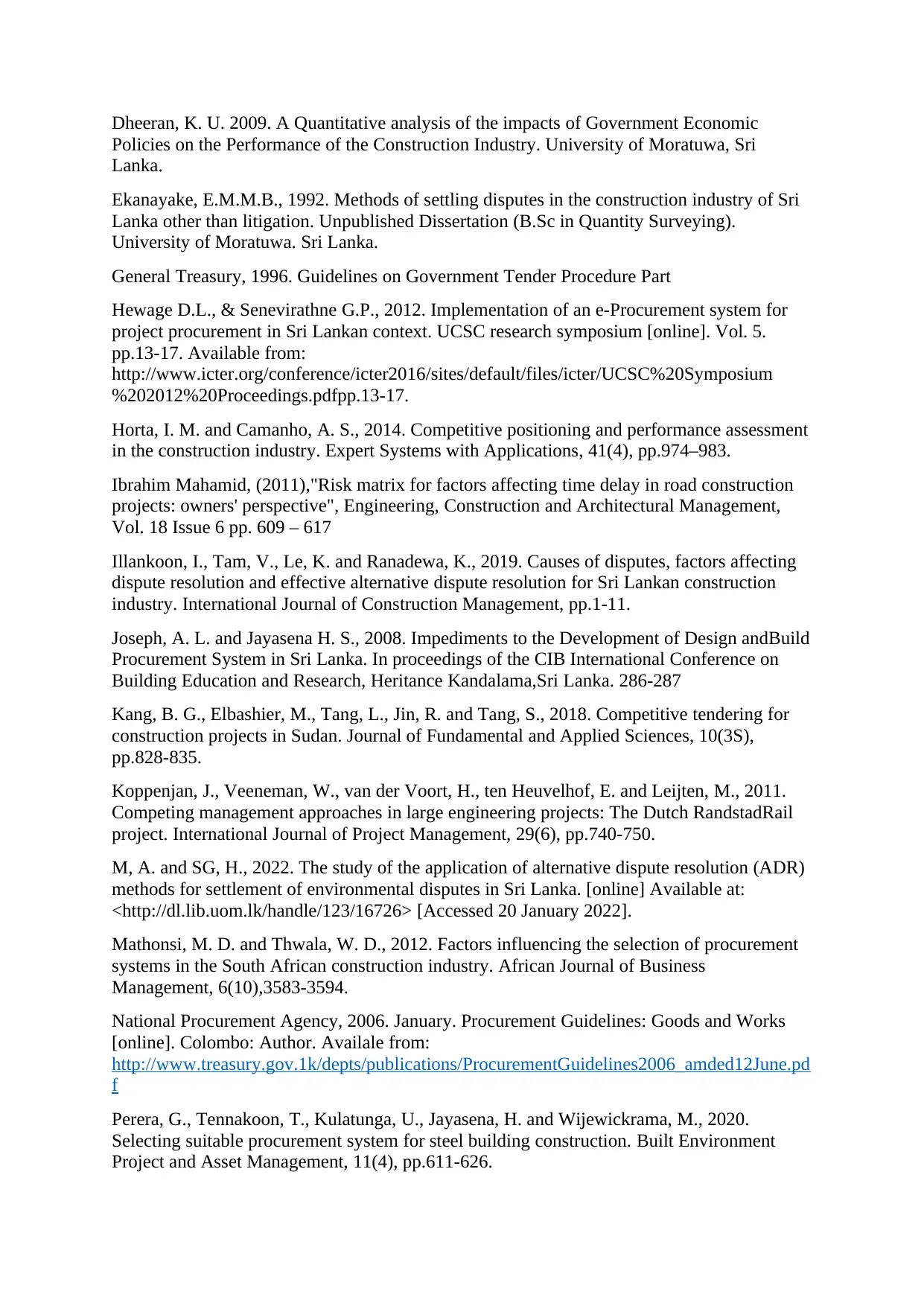
Dheeran, K. U. 2009. A Quantitative analysis of the impacts of Government Economic
Policies on the Performance of the Construction Industry. University of Moratuwa, Sri
Lanka.
Ekanayake, E.M.M.B., 1992. Methods of settling disputes in the construction industry of Sri
Lanka other than litigation. Unpublished Dissertation (B.Sc in Quantity Surveying).
University of Moratuwa. Sri Lanka.
General Treasury, 1996. Guidelines on Government Tender Procedure Part
Hewage D.L., & Senevirathne G.P., 2012. Implementation of an e-Procurement system for
project procurement in Sri Lankan context. UCSC research symposium [online]. Vol. 5.
pp.13-17. Available from:
http://www.icter.org/conference/icter2016/sites/default/files/icter/UCSC%20Symposium
%202012%20Proceedings.pdfpp.13-17.
Horta, I. M. and Camanho, A. S., 2014. Competitive positioning and performance assessment
in the construction industry. Expert Systems with Applications, 41(4), pp.974–983.
Ibrahim Mahamid, (2011),"Risk matrix for factors affecting time delay in road construction
projects: owners' perspective", Engineering, Construction and Architectural Management,
Vol. 18 Issue 6 pp. 609 – 617
Illankoon, I., Tam, V., Le, K. and Ranadewa, K., 2019. Causes of disputes, factors affecting
dispute resolution and effective alternative dispute resolution for Sri Lankan construction
industry. International Journal of Construction Management, pp.1-11.
Joseph, A. L. and Jayasena H. S., 2008. Impediments to the Development of Design andBuild
Procurement System in Sri Lanka. In proceedings of the CIB International Conference on
Building Education and Research, Heritance Kandalama,Sri Lanka. 286-287
Kang, B. G., Elbashier, M., Tang, L., Jin, R. and Tang, S., 2018. Competitive tendering for
construction projects in Sudan. Journal of Fundamental and Applied Sciences, 10(3S),
pp.828-835.
Koppenjan, J., Veeneman, W., van der Voort, H., ten Heuvelhof, E. and Leijten, M., 2011.
Competing management approaches in large engineering projects: The Dutch RandstadRail
project. International Journal of Project Management, 29(6), pp.740-750.
M, A. and SG, H., 2022. The study of the application of alternative dispute resolution (ADR)
methods for settlement of environmental disputes in Sri Lanka. [online] Available at:
<http://dl.lib.uom.lk/handle/123/16726> [Accessed 20 January 2022].
Mathonsi, M. D. and Thwala, W. D., 2012. Factors influencing the selection of procurement
systems in the South African construction industry. African Journal of Business
Management, 6(10),3583-3594.
National Procurement Agency, 2006. January. Procurement Guidelines: Goods and Works
[online]. Colombo: Author. Availale from:
http://www.treasury.gov.1k/depts/publications/ProcurementGuidelines2006_amded12June.pd
f
Perera, G., Tennakoon, T., Kulatunga, U., Jayasena, H. and Wijewickrama, M., 2020.
Selecting suitable procurement system for steel building construction. Built Environment
Project and Asset Management, 11(4), pp.611-626.
Policies on the Performance of the Construction Industry. University of Moratuwa, Sri
Lanka.
Ekanayake, E.M.M.B., 1992. Methods of settling disputes in the construction industry of Sri
Lanka other than litigation. Unpublished Dissertation (B.Sc in Quantity Surveying).
University of Moratuwa. Sri Lanka.
General Treasury, 1996. Guidelines on Government Tender Procedure Part
Hewage D.L., & Senevirathne G.P., 2012. Implementation of an e-Procurement system for
project procurement in Sri Lankan context. UCSC research symposium [online]. Vol. 5.
pp.13-17. Available from:
http://www.icter.org/conference/icter2016/sites/default/files/icter/UCSC%20Symposium
%202012%20Proceedings.pdfpp.13-17.
Horta, I. M. and Camanho, A. S., 2014. Competitive positioning and performance assessment
in the construction industry. Expert Systems with Applications, 41(4), pp.974–983.
Ibrahim Mahamid, (2011),"Risk matrix for factors affecting time delay in road construction
projects: owners' perspective", Engineering, Construction and Architectural Management,
Vol. 18 Issue 6 pp. 609 – 617
Illankoon, I., Tam, V., Le, K. and Ranadewa, K., 2019. Causes of disputes, factors affecting
dispute resolution and effective alternative dispute resolution for Sri Lankan construction
industry. International Journal of Construction Management, pp.1-11.
Joseph, A. L. and Jayasena H. S., 2008. Impediments to the Development of Design andBuild
Procurement System in Sri Lanka. In proceedings of the CIB International Conference on
Building Education and Research, Heritance Kandalama,Sri Lanka. 286-287
Kang, B. G., Elbashier, M., Tang, L., Jin, R. and Tang, S., 2018. Competitive tendering for
construction projects in Sudan. Journal of Fundamental and Applied Sciences, 10(3S),
pp.828-835.
Koppenjan, J., Veeneman, W., van der Voort, H., ten Heuvelhof, E. and Leijten, M., 2011.
Competing management approaches in large engineering projects: The Dutch RandstadRail
project. International Journal of Project Management, 29(6), pp.740-750.
M, A. and SG, H., 2022. The study of the application of alternative dispute resolution (ADR)
methods for settlement of environmental disputes in Sri Lanka. [online] Available at:
<http://dl.lib.uom.lk/handle/123/16726> [Accessed 20 January 2022].
Mathonsi, M. D. and Thwala, W. D., 2012. Factors influencing the selection of procurement
systems in the South African construction industry. African Journal of Business
Management, 6(10),3583-3594.
National Procurement Agency, 2006. January. Procurement Guidelines: Goods and Works
[online]. Colombo: Author. Availale from:
http://www.treasury.gov.1k/depts/publications/ProcurementGuidelines2006_amded12June.pd
f
Perera, G., Tennakoon, T., Kulatunga, U., Jayasena, H. and Wijewickrama, M., 2020.
Selecting suitable procurement system for steel building construction. Built Environment
Project and Asset Management, 11(4), pp.611-626.
Paraphrase This Document
Need a fresh take? Get an instant paraphrase of this document with our AI Paraphraser
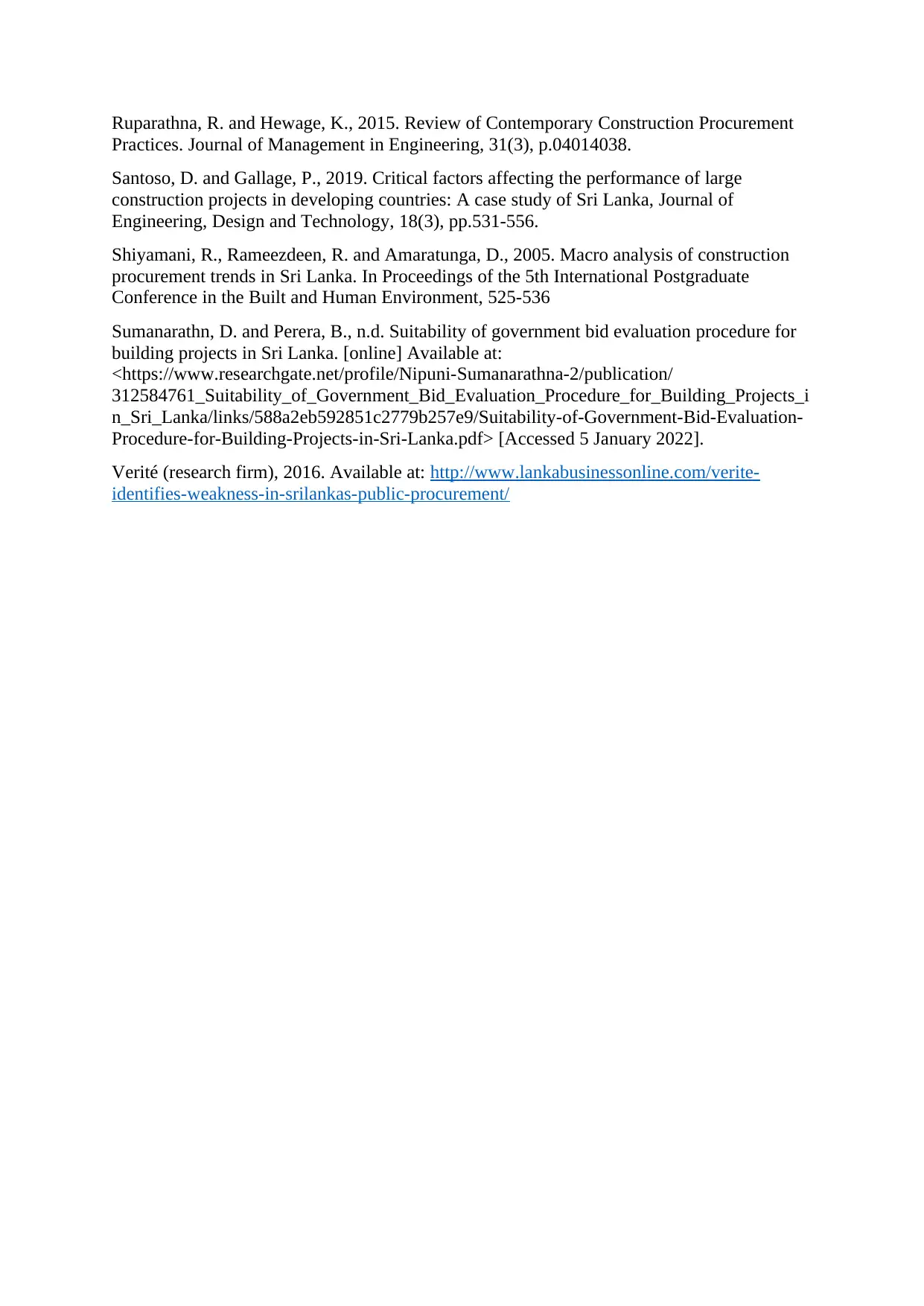
Ruparathna, R. and Hewage, K., 2015. Review of Contemporary Construction Procurement
Practices. Journal of Management in Engineering, 31(3), p.04014038.
Santoso, D. and Gallage, P., 2019. Critical factors affecting the performance of large
construction projects in developing countries: A case study of Sri Lanka, Journal of
Engineering, Design and Technology, 18(3), pp.531-556.
Shiyamani, R., Rameezdeen, R. and Amaratunga, D., 2005. Macro analysis of construction
procurement trends in Sri Lanka. In Proceedings of the 5th International Postgraduate
Conference in the Built and Human Environment, 525-536
Sumanarathn, D. and Perera, B., n.d. Suitability of government bid evaluation procedure for
building projects in Sri Lanka. [online] Available at:
<https://www.researchgate.net/profile/Nipuni-Sumanarathna-2/publication/
312584761_Suitability_of_Government_Bid_Evaluation_Procedure_for_Building_Projects_i
n_Sri_Lanka/links/588a2eb592851c2779b257e9/Suitability-of-Government-Bid-Evaluation-
Procedure-for-Building-Projects-in-Sri-Lanka.pdf> [Accessed 5 January 2022].
Verité (research firm), 2016. Available at: http://www.lankabusinessonline.com/verite-
identifies-weakness-in-srilankas-public-procurement/
Practices. Journal of Management in Engineering, 31(3), p.04014038.
Santoso, D. and Gallage, P., 2019. Critical factors affecting the performance of large
construction projects in developing countries: A case study of Sri Lanka, Journal of
Engineering, Design and Technology, 18(3), pp.531-556.
Shiyamani, R., Rameezdeen, R. and Amaratunga, D., 2005. Macro analysis of construction
procurement trends in Sri Lanka. In Proceedings of the 5th International Postgraduate
Conference in the Built and Human Environment, 525-536
Sumanarathn, D. and Perera, B., n.d. Suitability of government bid evaluation procedure for
building projects in Sri Lanka. [online] Available at:
<https://www.researchgate.net/profile/Nipuni-Sumanarathna-2/publication/
312584761_Suitability_of_Government_Bid_Evaluation_Procedure_for_Building_Projects_i
n_Sri_Lanka/links/588a2eb592851c2779b257e9/Suitability-of-Government-Bid-Evaluation-
Procedure-for-Building-Projects-in-Sri-Lanka.pdf> [Accessed 5 January 2022].
Verité (research firm), 2016. Available at: http://www.lankabusinessonline.com/verite-
identifies-weakness-in-srilankas-public-procurement/
1 out of 11
Related Documents
Your All-in-One AI-Powered Toolkit for Academic Success.
+13062052269
info@desklib.com
Available 24*7 on WhatsApp / Email
![[object Object]](/_next/static/media/star-bottom.7253800d.svg)
Unlock your academic potential
Copyright © 2020–2025 A2Z Services. All Rights Reserved. Developed and managed by ZUCOL.





